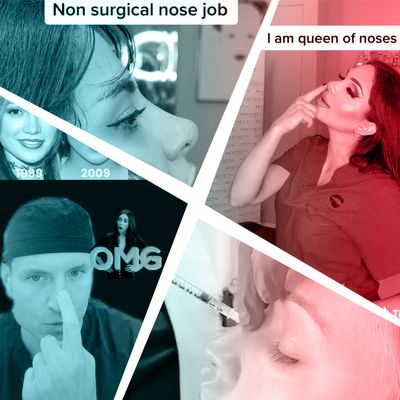
Eurocentric beauty standards are at it again, folks! When Famously Beautiful Woman Bella Hadid recently expressed regret over the rhinoplasty she got at 14 years old, I felt for her. Hadid’s struggle with self-acceptance — and her remorse for (quite literally) erasing her Palestinian heritage — is a familiar one.
In the throes of my own insecurity, I, too, as the dithering owner of a crooked Jewish nose, almost fell victim to tiny-nose propaganda. As in, I actually had a surgery date in the books. But ultimately a designer nose that cost as much as a year of college was simply out of the question. After some digging, I came across an option that seemed much more doable: injections of nasal filler that have earned the nickname “liquid rhinoplasty.” These nonsurgical nose jobs seem great: low-cost, impermanent, and require no recovery time.
But if it sounds too good to be true, that’s because it is. Liquid rhinoplasties carry potential risks so devastating that even some highly trained plastic surgeons downright refuse to perform them.
The procedure is especially popular on TikTok. The hashtag #LiquidRhinoplasty has exploded over the past two years, racking up 72.5 million views and counting. Not long after joining the app, I found my own “For You Page” crawling with advertisements for a same-day fix that promised to “refine” my profile with a camouflaged dorsal hump and an “adorable” tip. The astronomical risks involved didn’t make the cut.
So what exactly is this procedure, and why are so many medical professionals wary of it? Let’s dive in.
What is a liquid rhinoplasty?
“Nonsurgical nose job” is a bit of a misnomer, according to Dr. Rod Rohrich, a Dallas-based board-certified plastic surgeon who co-authored a 2020 study on the safety of nasal fillers. A liquid rhinoplasty utilizes syringes of filler to reshape the nose and disguise bumps. Dr. Rohrich emphasizes that the safest filler is hyaluronic acid, a natural biodegradable substance that is also common in lips, chins, and cheeks (oh my!). “You should never use a permanent filler to the nose,” he says, cautioning against silicone.
One draw for the chronically indecisive: The filler degrades naturally over time or can be dissolved on the spot by a medical professional. “Younger patients want to sometimes try it to see how they like it, kind of like driving it before you get it,” Rohrich says. Filler goes for several hundred to a few thousand dollars, far cheaper than surgery. (A regular rhinoplasty can set you back between $5,000 and $10,000.) Price varies depending on units of filler, geographical location, and injector expertise. But beware, if downsizing is the name of your game, this probably isn’t the procedure for you. While liquid rhinoplasties giveth, only surgery can taketh away.
Where did this start?
TikTok has become something of a digital portfolio for plastic surgeons. (TikTok historians are surely haunted by the sound, “Ayo, nose job check.”) In an April 2020 video with more than 675,000 views, Dr. Daniel Barrett theorized that Jennifer Lopez had a liquid rhinoplasty. Since then, TikTok surgeons and aestheticians like @beautybydrkay and @aestheticcliniclondon have regularly populated the hashtag with homogenous profiles, and comments sections are overrun with people declaring “I NEED THIS” and “Taking this as my sign.” Rhinoplasties consistently rank in the top five most popular cosmetic surgeries among Americans, and the data is well reflected on TikTok. #NoseJob has a staggering 3.9 billion views to date, while #LiquidRhinoplasty follows with 72.5 million.
So should I do this?
Not without a highly skilled injector and knowledge of potential complications. “This is very technique- and injector-dependent,” Rohrich says. “You can lose the skin of your nose. You can go blind. It can be very dangerous if not done correctly.” The nose is dense with arteries, many of which lead to the eyes. One wrong move can leave a patient with irreversible damage. While the danger isn’t quantifiable with data yet, Rohrich anecdotally knows of many skilled injectors who refuse to perform the procedure. “There’s a lot of filler experts who will not do fillers to the nose because it’s got this potential for really bad complications,” he says.
Who can perform liquid rhinoplasty? (And who should?)
You can, terrifyingly, get a nonsurgical nose job just about anywhere, from a dermatologist’s office to a med-spa. While doctors, nurse practitioners, and even dentists are qualified to perform a nasal filler with proper training, that doesn’t mean you should get one next time you’re getting a cavity filled. Rohrich cautions that only board-certified plastic surgeons (particularly rhinoplasty experts) should be tasked with such a high-risk and aesthetically oriented procedure. “It’s way beyond just the cost; it’s the expertise,” he says. “And your nose and your eyes.”
What can I do instead?
For those interested in the long-term effects, surgery is probably your best bet. But if going under the knife isn’t for you, maybe take to TikTok for nose-contouring tips instead.

